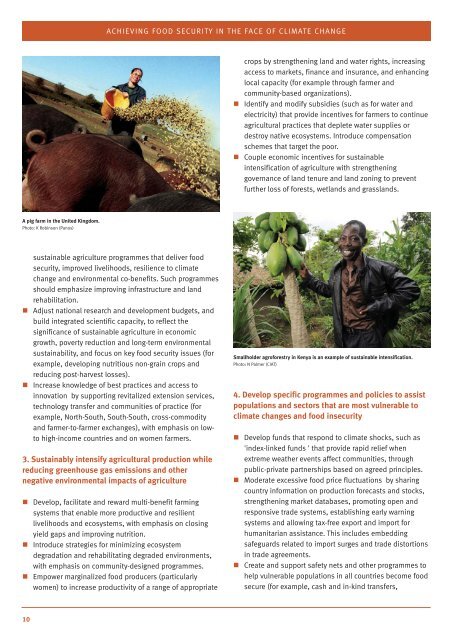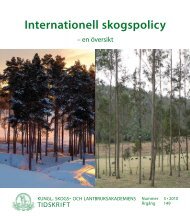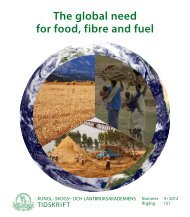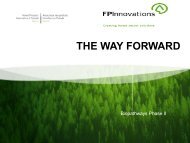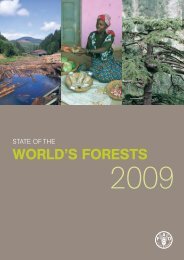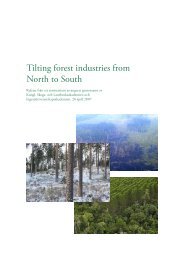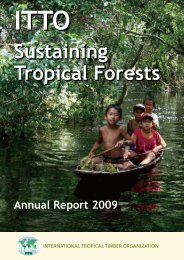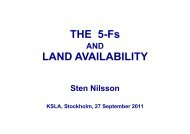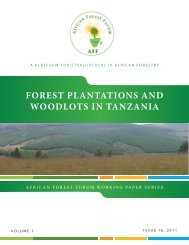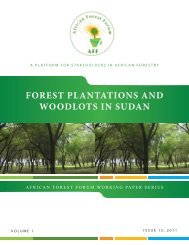Achieving food security in the face of climate change - CGSpace ...
Achieving food security in the face of climate change - CGSpace ...
Achieving food security in the face of climate change - CGSpace ...
You also want an ePaper? Increase the reach of your titles
YUMPU automatically turns print PDFs into web optimized ePapers that Google loves.
ACHIEVING FOOD SECURITY IN THE FACE OF CLIMATE CHANGE<br />
crops by streng<strong>the</strong>n<strong>in</strong>g land and water rights, <strong>in</strong>creas<strong>in</strong>g<br />
access to markets, f<strong>in</strong>ance and <strong>in</strong>surance, and enhanc<strong>in</strong>g<br />
local capacity (for example through farmer and<br />
community-based organizations).<br />
• Identify and modify subsidies (such as for water and<br />
electricity) that provide <strong>in</strong>centives for farmers to cont<strong>in</strong>ue<br />
agricultural practices that deplete water supplies or<br />
destroy native ecosystems. Introduce compensation<br />
schemes that target <strong>the</strong> poor.<br />
• Couple economic <strong>in</strong>centives for susta<strong>in</strong>able<br />
<strong>in</strong>tensification <strong>of</strong> agriculture with streng<strong>the</strong>n<strong>in</strong>g<br />
governance <strong>of</strong> land tenure and land zon<strong>in</strong>g to prevent<br />
fur<strong>the</strong>r loss <strong>of</strong> forests, wetlands and grasslands.<br />
A pig farm <strong>in</strong> <strong>the</strong> United K<strong>in</strong>gdom.<br />
Photo: K Rob<strong>in</strong>son (Panos)<br />
susta<strong>in</strong>able agriculture programmes that deliver <strong>food</strong><br />
<strong>security</strong>, improved livelihoods, resilience to <strong>climate</strong><br />
<strong>change</strong> and environmental co-benefits. Such programmes<br />
should emphasize improv<strong>in</strong>g <strong>in</strong>frastructure and land<br />
rehabilitation.<br />
• Adjust national research and development budgets, and<br />
build <strong>in</strong>tegrated scientific capacity, to reflect <strong>the</strong><br />
significance <strong>of</strong> susta<strong>in</strong>able agriculture <strong>in</strong> economic<br />
growth, poverty reduction and long-term environmental<br />
susta<strong>in</strong>ability, and focus on key <strong>food</strong> <strong>security</strong> issues (for<br />
example, develop<strong>in</strong>g nutritious non-gra<strong>in</strong> crops and<br />
reduc<strong>in</strong>g post-harvest losses).<br />
• Increase knowledge <strong>of</strong> best practices and access to<br />
<strong>in</strong>novation by support<strong>in</strong>g revitalized extension services,<br />
technology transfer and communities <strong>of</strong> practice (for<br />
example, North-South, South-South, cross-commodity<br />
and farmer-to-farmer ex<strong>change</strong>s), with emphasis on lowto<br />
high-<strong>in</strong>come countries and on women farmers.<br />
3. Susta<strong>in</strong>ably <strong>in</strong>tensify agricultural production while<br />
reduc<strong>in</strong>g greenhouse gas emissions and o<strong>the</strong>r<br />
negative environmental impacts <strong>of</strong> agriculture<br />
• Develop, facilitate and reward multi-benefit farm<strong>in</strong>g<br />
systems that enable more productive and resilient<br />
livelihoods and ecosystems, with emphasis on clos<strong>in</strong>g<br />
yield gaps and improv<strong>in</strong>g nutrition.<br />
• Introduce strategies for m<strong>in</strong>imiz<strong>in</strong>g ecosystem<br />
degradation and rehabilitat<strong>in</strong>g degraded environments,<br />
with emphasis on community-designed programmes.<br />
• Empower marg<strong>in</strong>alized <strong>food</strong> producers (particularly<br />
women) to <strong>in</strong>crease productivity <strong>of</strong> a range <strong>of</strong> appropriate<br />
Smallholder agr<strong>of</strong>orestry <strong>in</strong> Kenya is an example <strong>of</strong> susta<strong>in</strong>able <strong>in</strong>tensification.<br />
Photo: N Palmer (CIAT)<br />
4. Develop specific programmes and policies to assist<br />
populations and sectors that are most vulnerable to<br />
<strong>climate</strong> <strong>change</strong>s and <strong>food</strong> <strong>in</strong><strong>security</strong><br />
• Develop funds that respond to <strong>climate</strong> shocks, such as<br />
'<strong>in</strong>dex-l<strong>in</strong>ked funds ' that provide rapid relief when<br />
extreme wea<strong>the</strong>r events affect communities, through<br />
public-private partnerships based on agreed pr<strong>in</strong>ciples.<br />
• Moderate excessive <strong>food</strong> price fluctuations by shar<strong>in</strong>g<br />
country <strong>in</strong>formation on production forecasts and stocks,<br />
streng<strong>the</strong>n<strong>in</strong>g market databases, promot<strong>in</strong>g open and<br />
responsive trade systems, establish<strong>in</strong>g early warn<strong>in</strong>g<br />
systems and allow<strong>in</strong>g tax-free export and import for<br />
humanitarian assistance. This <strong>in</strong>cludes embedd<strong>in</strong>g<br />
safeguards related to import surges and trade distortions<br />
<strong>in</strong> trade agreements.<br />
• Create and support safety nets and o<strong>the</strong>r programmes to<br />
help vulnerable populations <strong>in</strong> all countries become <strong>food</strong><br />
secure (for example, cash and <strong>in</strong>-k<strong>in</strong>d transfers,<br />
10


